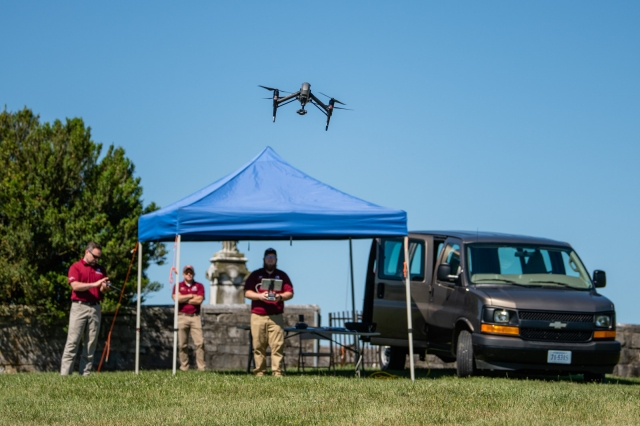Over nearly a week of testing — a week that followed months of preparation and involved five types of aircraft, four aircraft software systems, more than 30 engineers, pilots, and operations experts, and 141 flights — the Virginia Tech Mid-Atlantic Aviation Partnership and its partners sought to answer an increasingly urgent question: How can we effectively manage the diversity and volume of drone traffic we’re expecting?
The tests were part of a Federal Aviation Administration initiative known as the UAS Traffic Management Pilot Program, or UPP. The program, designed to help transition drone traffic management from the research phase toward commercial viability, is the latest stage of a long-term federal effort to facilitate the development of technology and protocols that are becoming imperative as commercial demand for drone use climbs.
Previous phases of the research, some of which was conducted at Virginia Tech, have been managed by NASA; now the program is transitioning to the FAA for implementation. This particular series of tests evaluated the maturity of the technology and yielded data that can guide the regulatory organization as they consider new policies for drone use.
The Virginia Tech Mid-Atlantic Aviation Partnership (MAAP), which runs the university’s FAA-designated drone test site, was selected in February to participate in the program.
“This was a pivotal series of tests,” said Mark Blanks, MAAP’s director. “You can’t achieve UAS integration without UAS traffic management, which is why we’ve been heavily engaged in this research for years. Now we’re seeing the technology evolve to a level where it’s close to being deployable in the real world, and it’s incredibly rewarding to imagine the operations that are going to be possible because of this work.”
Solving the traffic-management problem is one of the key hurdles to widespread integration. Currently, commercial drone use is subject to strict regulations that reduce risk but sharply limit the range of possible applications — without a specific waiver, the aircraft can’t fly over people or beyond the pilot’s visual line of sight, among other restrictions.
If some of the risk reduction that’s currently achieved by these regulations could be handled instead by traffic-management software — ensuring that drones stay away from each other, away from manned air traffic, and out of areas where their presence might create an undue hazard — more types of flights could be permitted safely.
“I’d say 98 or 99 percent of UAS economic potential is yet to be realized until we have routine flights beyond visual line of sight,” explained John Coggin, MAAP’s chief engineer and the director of the test program. “Right now pilots are expected to manage the airspace and deconflict with other air traffic visually, and that obviously doesn’t work beyond visual line of sight. Unmanned traffic management is not only a core piece of the puzzle — it’s the umbrella under which all the other pieces get plugged in.”
Investigating and validating the feasibility of this approach has been a multi-year project involving extensive collaboration among federal agencies, the UAS industry, and test sites like MAAP.
Because drone traffic management will be handled by commercial software, with oversight from the FAA, industry engagement in research and testing has been essential. For the UPP, MAAP teamed up with commercial partners AirMap, AiRXOS (part of GE Aviation), ANRA Technologies, and Wing, all of whom have developed their own traffic-management platforms.
MAAP and its partners planned and executed a series of increasingly complex real and simulated flights representing real-world missions like package delivery, agricultural surveying, and newsgathering. Each drone operator filed flight plans in advance, with traffic-management systems from the four different providers sharing information to ensure that the proposed operations didn’t interfere with each other or edge into prohibited areas. As the flights unfolded, the systems needed to communicate seamlessly to keep track of each operation.
One key segment of the test assessed whether the software could accommodate an unexpected change. In this case, as four different drone operations were in progress at various locations around the Kentland Farms test site, each operator received an alert: a medical helicopter needed to fly through the area. (While the drones in this test were real, the helicopter wasn’t — the flight area it needed was represented by a red-bordered box that popped up on the view screen.)
Each of the four original operations needed to make sure they stayed out of the airspace reserved by the helicopter. In this case, three adjusted their routes or halted certain flight paths to stay out of the helicopter’s way; one drone simply landed until the restriction was lifted. The team executed that sequence multiple times over the course of the week, along with several iterations of other test sequences.
“It’s challenging, and exciting, to bring a disparate set of UAS operations into a common theater and begin to understand how they can interact and coexist,” Coggin said. “There aren’t many opportunities to see the density of operations that we did during these tests, and you always learn a lot about what needs to be coordinated and the best way to do it.”
Two other sites also participated in the UPP: North Dakota’s Northern Plains UAS Test Site and the Nevada UAS Test Site Smart Silver State program.

